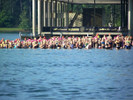Cutting Calories During a Transition Phase for Ironman
Posted by Matt Russ on 27th Jul 2018
The biggest drop in activity factor occurs during transition, and transition occurs directly after a peak (race) phase in most cases. This is the time to allow the body to heal and recover from the intense stress it was under. What is important to recognize is that athletes being creatures of habit often continue to eat as if peaking and training full bore. This is especially true for ultra-endurance athletes, such as IronMan athletes, in which this shift in activity is most acute. In fact their bodies, already under great stress, may be more apt to store calories. When in a stressed state the body produces more cortisol which signals it to store calories. This combined with a huge drop in activity factor and metabolic shift often produce rapid weight gain. Athletes that have relatively consistent annual training schedules are more likely to reach a state of homeostasis calorie wise in which what is consumed is utilized. That is not to say they don't have to watch what they eat, but compared to ultra-distance athletes that have large swings in training volume, they are more balanced. I have heard athletes remark "where did my Ironman body go?" a month or so post race; the solution being to sign up for another Ironman. But this is a poor weight management program!
Using myself for example, I attended a 4 day seminar following my peak. This was my first week of transition, and it meant sitting in a chair all day vs. my normally active job plus training. I calculated then lowered my calorie intake by almost 1000 calories per day. If I had continued to eat as I was the week before I would have gained around a pound in just those four days.
Drastic changes in activity factor call for changes in diet. This means cutting out the energy bars and drinks that were a staple during your peaking period, and cutting out some of the post-workout calories. If you workouts are under one hour you do not need a recovery meal directly after your work out. Just make sure you are going to eat a meal within 2 hours. Switch your carbs from starches (pasta, bread, cereals, etc...) to more fibrous carbs. such as fruits and vegetables. On your rest days watch the caloric intake even more. You may want to switch to a lighter dinner of lean protein source and vegetables or salad. If you usually consume an energy bar for a snack, a better alternative would be a piece of fruit and a small amount of nuts. Meals should not only shift in amount of calories but types of calories meaning less high glycemic starches and grains, and less dairy. These foods are very high energy but only if you are burning a lot of energy. Extremes are not called for, just a series of smaller changes in amount and type of calories. These changes will help keep the weight off going into your winter base training. Weight gain for athletes is not just aesthetic, those extra pounds mean extra stress on the joints and connective tissue, and lost performance. Having a plan in place will help you avoid the pitfall of attempting to lose weight when your training volume increases- one of the hardest things to do. Your body needs more energy for the increased training volume at the same time you are trying to create a deficit for weight loss. It is much preferable to try to keep the weight off.


